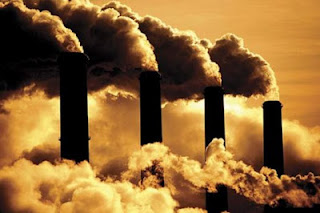By: Vanessa Rogers, Staff Member
Many
utility companies have switched from coal to natural gas.[1] More than 100 of the 500 coal-burning
power plants in the United States are expected to close in the next few years.[2] “Power plants that burn coal produce
more than 90 times as much sulfur dioxide, five times as much nitrogen oxide
and twice as much carbon dioxide as those that run on natural gas.”[3] Sulfur dioxide causes acid rain;
nitrogen oxides cause smog; and carbon dioxide traps heat in the atmosphere.”[4]
Natural gas plants, on the other hand, emit almost no harmful toxins.[5] Many blame the switch to environmental
friendly energy on the tough environmental regulations that have been
implemented.[6] However, the Environmental Protection
Agency (EPA) said that coal is still expected to generate more of the country’s
electricity than any other fuel source.[7]
Despite
the dispute over why coal companies are shutting down, one thing is for
certain, coal company closures caused many to lose their jobs.[8] A month ago one of the world’s largest
coal producers, Arch Coal Inc., said it would lay off about 750 workers in
Kentucky, Virginia, and West Virginia coalfields.[9] Almost 600 of those cuts are in
Kentucky.[10] Perry County has estimated a loss of
about 30% of its mining jobs in the last year.[11] There are predictions that the share of
U.S. electricity coming from coal will fall below 40% for the year, the lowest
since the forecasts that the government began collecting data in 1949.[12]
So
what does all of this mean for the future of energy? “One of the big issues with the EPA rules is that with all
these coal plants coming off-line in 2015, even if natural gas prices are
reasonable we just don’t have the pipeline capacity to get it where you need
it,” said Jeffrey R. Holmstead, a former assistant administrator for the U.S.
EPA and current head of the Environmental Strategies Group of
Bracewell-Giuliani, which advocates for the coal industry.[13] Because natural gas has a much lower
carbon emissions, it can meet the
recently-announced EPA proposed greenhouse gas standards while conventional
coal plants could not, if the proposal passes.[14] In addition, coal companies may take
their businesses overseas. Some
coal producers, such as Arch Coal Inc., have already done so. Overseas, coal power plants are being
built faster than they are being abandoned in the United States.[15]
[1]
Bruce Schreiner, Mine Layoffs latest sign
of Coal Industry’s Decline, LJWorld.com
(June 22, 2012), http://m.ljworld.com/news/2012/jun/22mine-layoffs-latest-sign-coal-industrys-decline/.
[2]
Erik Lipton, Even in Coal Country, the
Fight for an Industry, NY Times
(May 29, 2012), http://www.nytimes.com/2012/05/30/business/energy-environment/even-in-kentucky-coal-industry-is-under-siege.html?pagewanted=all.
[3]
Schreiner, supra note 1.
[4]
Id.
[5]
(April 17, 2012), http://www.midwestenergynews.com/2012/04/17/is-natural-gas-killing-coal/.
[6]
Schreiner, supra note 1.
[7]
Id.
[8]
Id.
[9]
Id.
[10]
Id.
[11]
Id.
[12]
Bruce Schreiner, Mine Layoffs latest sign
of Coal Industry’s Decline, LJWorld.com,
http://m.ljworld.com/news/2012/jun/22mine-layoffs-latest-sign-coal-industrys-decline/
(June 22, 2012).
[13]
[14] Id.
[15]
Lipton, supra note 2.

No comments:
Post a Comment